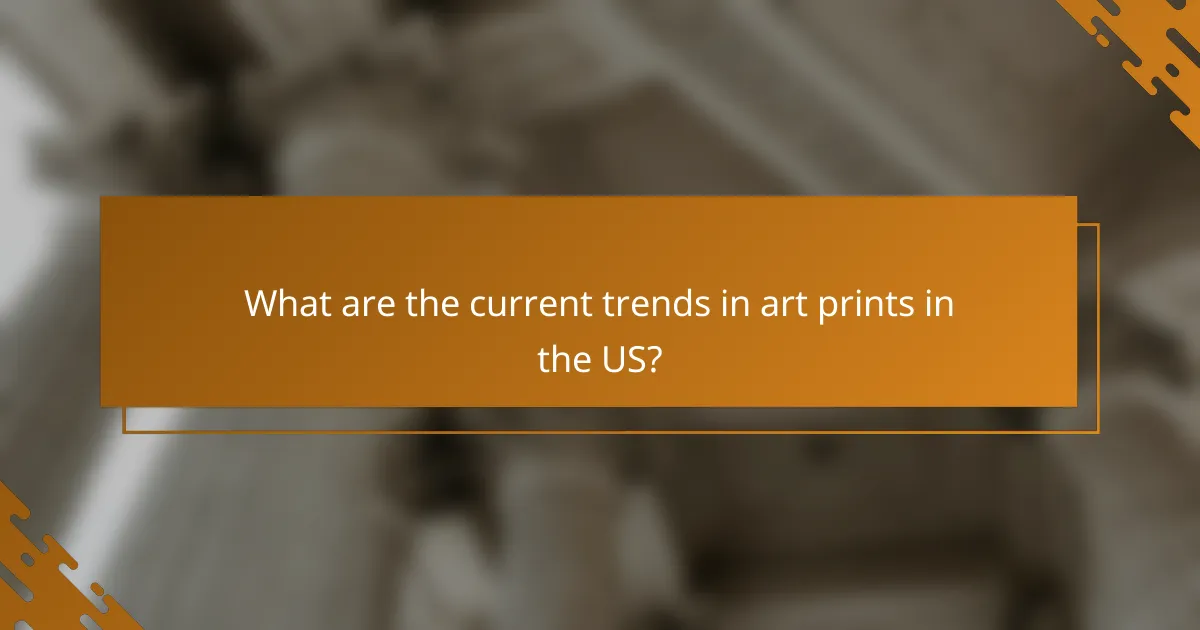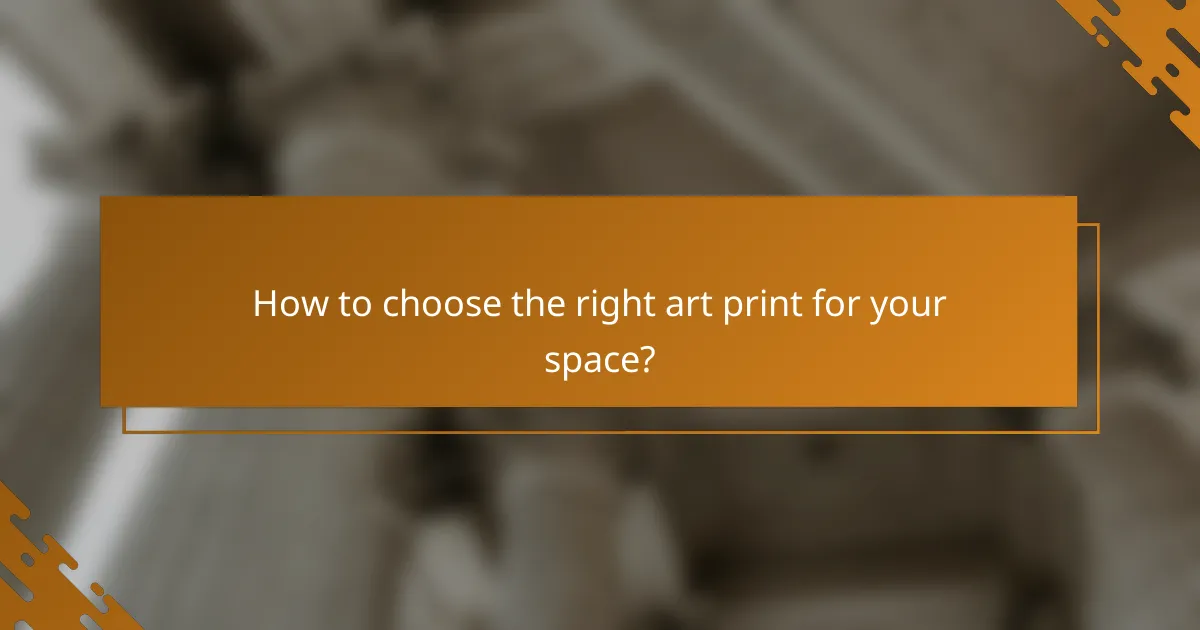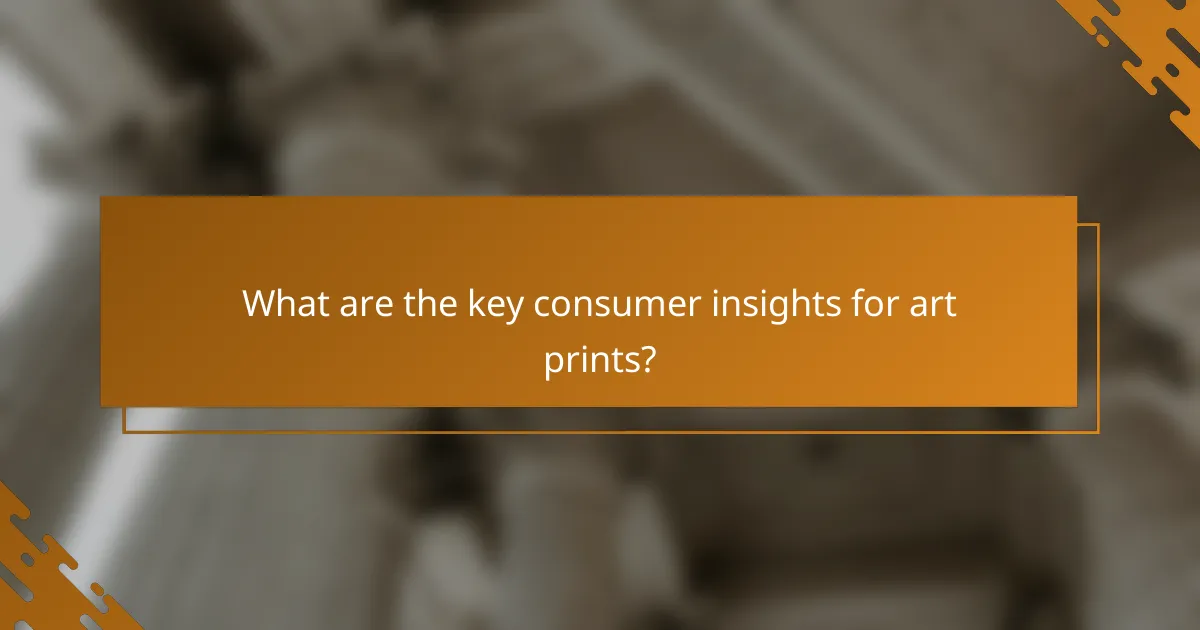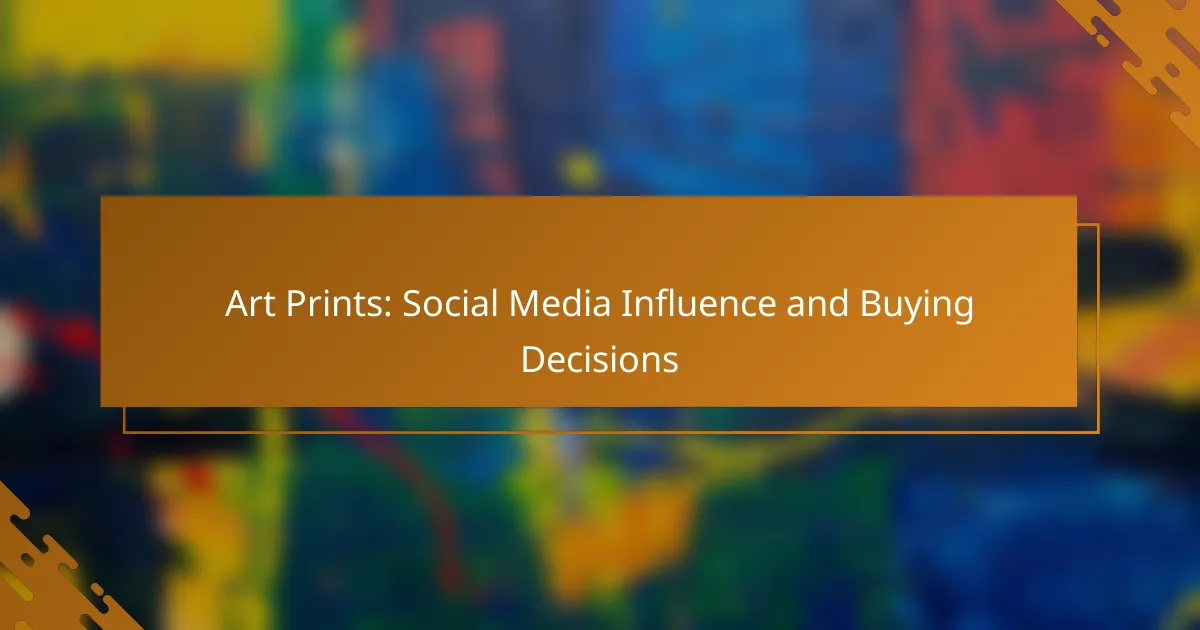The art print market in the US is experiencing a notable transformation, driven by consumer preferences for sustainability, digital formats, and the convenience of online shopping. As buyers increasingly seek eco-friendly and accessible options, understanding the nuances of demographic preferences, particularly among Millennials and Gen Z, becomes essential for artists and retailers alike. Selecting the right art print not only enhances aesthetic appeal but also reflects individual style and values.

What are the current trends in art prints in the US?
The current trends in art prints in the US reflect a growing consumer interest in sustainability, digital formats, and online purchasing platforms. These trends indicate a shift towards more accessible and eco-friendly options in the art market.
Increased demand for sustainable materials
Consumers are increasingly prioritizing sustainability when purchasing art prints. This trend has led to a rise in the use of eco-friendly materials such as recycled paper and non-toxic inks. Artists and printmakers are responding by sourcing sustainable resources to meet this demand.
Additionally, many buyers are willing to pay a premium for prints that are produced using environmentally responsible practices. This shift not only supports eco-conscious artists but also aligns with broader consumer values regarding environmental impact.
Popularity of digital art prints
Digital art prints have gained significant traction among consumers, offering unique advantages such as affordability and ease of access. Artists can create and sell digital prints without the costs associated with traditional printing methods, making art more accessible to a wider audience.
Moreover, the ability to easily reproduce digital art allows for a variety of sizes and formats, catering to diverse consumer preferences. This flexibility has made digital prints a popular choice for both personal and commercial spaces.
Growth in online art marketplaces
The rise of online art marketplaces has transformed how consumers purchase art prints. Platforms like Etsy, Saatchi Art, and others provide artists with a global audience, while buyers benefit from a vast selection of artwork at their fingertips. This convenience has led to increased sales and visibility for independent artists.
As online shopping continues to grow, consumers are encouraged to explore various platforms to find unique prints that resonate with their tastes. However, buyers should be mindful of verifying the authenticity and quality of prints before making a purchase to ensure satisfaction.

How to choose the right art print for your space?
Choosing the right art print involves considering factors like size, style, and color to ensure it complements your space. A well-selected piece can enhance the overall aesthetic and create a cohesive look in your home or office.
Consider the size and scale
The size of the art print should be proportional to the wall and the surrounding furniture. Large prints can serve as focal points, while smaller pieces can be grouped to create a gallery wall effect. Aim for a balance; a common guideline is to leave at least 15-25 cm of space around the artwork for visual breathing room.
When measuring, consider the height of the furniture and the average eye level, which is typically around 150-160 cm from the floor. This ensures that the art is displayed at an optimal viewing height.
Match the style to your decor
Your art print should reflect the overall style of your space, whether it’s modern, traditional, or eclectic. For instance, a minimalist print works well in a contemporary setting, while vintage art can enhance a classic room. Consider the existing decor elements, such as furniture and textiles, to create harmony.
Mixing styles can be effective, but aim for a cohesive theme. For example, if your decor is predominantly neutral, a bold, colorful print can add interest without clashing.
Evaluate the color palette
The colors in your art print should complement the existing color scheme of your space. Look for hues that match or contrast effectively with wall colors, furniture, and accessories. A good approach is to select a print that incorporates at least one color from your decor to tie the room together.
Consider the mood you want to create; warm tones can evoke coziness, while cool tones may promote calmness. If you’re unsure, using a color wheel can help identify complementary colors that will enhance your space.

What are the key consumer insights for art prints?
Key consumer insights for art prints reveal preferences that vary significantly across demographics, particularly among Millennials and Gen Z. Understanding these insights can help artists and retailers tailor their offerings to meet the demands of different consumer segments.
Millennials prefer affordable options
Millennials are often drawn to affordable art prints, typically valuing cost-effectiveness over high-end pieces. Many in this demographic are willing to spend between $50 to $150 for prints that fit their aesthetic without breaking the bank.
When marketing to Millennials, emphasize promotions, discounts, and bundles to attract this budget-conscious group. Offering a range of sizes can also appeal to their desire for flexibility in pricing.
Gen Z values unique and personalized art
Gen Z consumers prioritize unique and personalized art prints, often seeking pieces that reflect their individual identities and experiences. This generation is more inclined to invest in custom artworks or limited editions, even if they come at a higher price point.
To cater to Gen Z, consider offering customizable options or collaborations with emerging artists. Engaging them through social media platforms can also enhance their connection to the art and the artist.
Interest in local artists is rising
There is a growing interest in supporting local artists among consumers of all ages, particularly in urban areas. Many buyers prefer to purchase art prints that are locally sourced, as this fosters community support and sustainability.
Highlighting local artists in your marketing strategy can attract consumers who are passionate about supporting their communities. Hosting local art fairs or exhibitions can also create a direct connection between artists and potential buyers, enhancing the appeal of local art prints.

How to price art prints competitively?
To price art prints competitively, start by researching the market and understanding your costs. Effective pricing balances affordability for consumers while ensuring profitability for artists and sellers.
Analyze competitor pricing
Begin by examining the prices of similar art prints offered by competitors. Look at both online platforms and local galleries to gather a range of prices. This will help you identify the average price point and any outliers that may indicate premium or budget options.
Consider factors like the artist’s reputation, print size, and medium when comparing prices. For instance, limited edition prints may command higher prices than open editions, so take note of these distinctions in your analysis.
Factor in production costs
Calculate all production costs associated with creating your art prints, including materials, printing, and shipping. Understanding these costs is crucial for setting a price that covers expenses while remaining attractive to buyers.
For example, if a print costs around $10 to produce, you might consider pricing it at least 2-3 times that amount to ensure a reasonable profit margin. Keep in mind that higher quality materials may justify a higher price point.
Consider perceived value and branding
Perceived value plays a significant role in pricing art prints. If your brand is well-established or if the artwork has a unique story, you can often charge more. Invest in branding efforts that communicate quality and exclusivity to enhance perceived value.
Additionally, consider offering different pricing tiers based on factors like print size or framing options. This allows you to cater to a broader audience while maximizing potential revenue from higher-end offerings.

What are the best platforms for selling art prints online?
The best platforms for selling art prints online include Etsy, Society6, and Redbubble, each catering to different artist needs and consumer preferences. Choosing the right platform depends on whether you focus on handmade items, collaborations, or print-on-demand services.
Etsy for handmade and unique items
Etsy is ideal for artists who create handmade or one-of-a-kind art prints. This platform allows you to set up a personalized shop, showcasing your unique style and connecting directly with buyers who appreciate craftsmanship.
When selling on Etsy, consider the costs associated with listing items and transaction fees, which can vary. It’s essential to optimize your shop’s SEO to improve visibility and attract potential customers.
Society6 for artist collaborations
Society6 focuses on artist collaborations, allowing creators to upload their designs and have them printed on various products, including art prints. This platform handles production, shipping, and customer service, letting artists concentrate on their creative work.
Artists earn a commission on each sale, typically set by Society6, which can be a fixed percentage. It’s beneficial to promote your work through social media to drive traffic to your Society6 shop.
Redbubble for print-on-demand services
Redbubble offers print-on-demand services, making it easy for artists to sell their designs on a wide range of products, including art prints. This model eliminates upfront costs, as products are created only after a sale is made.
Artists receive a royalty based on the markup they set above Redbubble’s base price. To maximize earnings, consider pricing strategies and actively promote your designs through various online channels.

What are the benefits of using eco-friendly materials for art prints?
Using eco-friendly materials for art prints offers significant advantages, including reduced environmental impact and appeal to a growing market of conscious consumers. These materials often use sustainable sources and non-toxic inks, making them safer for both the planet and the people who use them.
Attract environmentally conscious consumers
Eco-friendly art prints resonate with consumers who prioritize sustainability in their purchasing decisions. By offering products made from recycled or sustainably sourced materials, businesses can tap into a demographic that increasingly seeks to support brands aligned with their values.
For example, a study found that a significant portion of millennials and Gen Z are willing to pay more for products that are environmentally friendly. This trend suggests that incorporating eco-friendly materials can enhance sales potential and customer loyalty.
Enhance brand reputation
Utilizing eco-friendly materials can significantly boost a brand’s reputation. Companies that commit to sustainability often gain recognition as leaders in environmental responsibility, which can differentiate them from competitors.
Additionally, brands that actively promote their use of sustainable materials can engage in effective marketing campaigns that highlight their commitment to the environment. This can lead to increased media coverage and positive consumer perception, further solidifying their market position.



